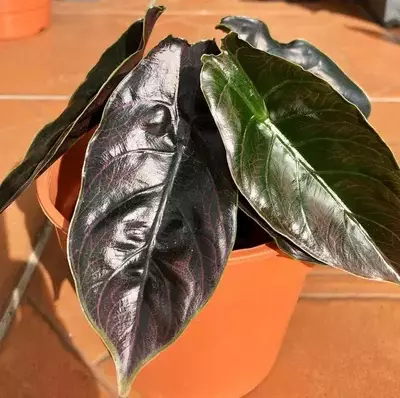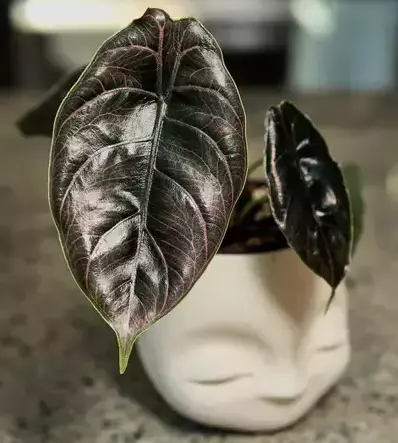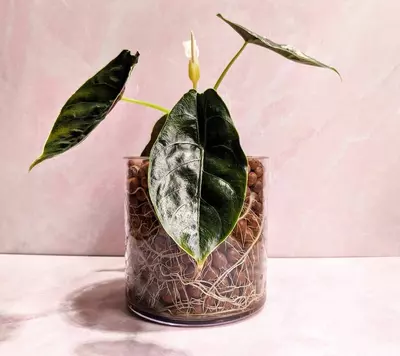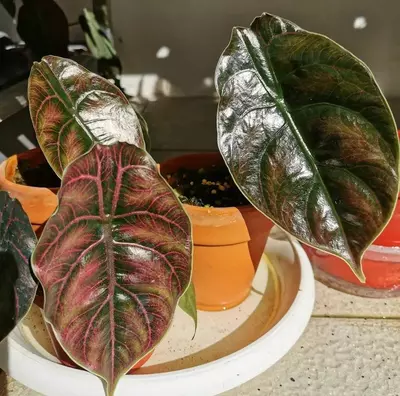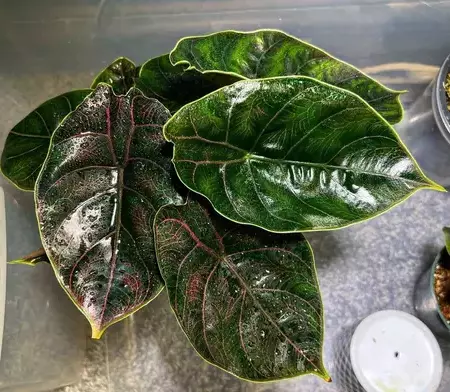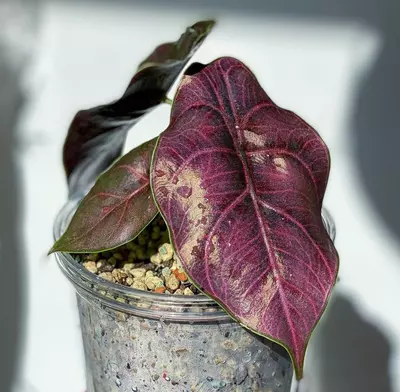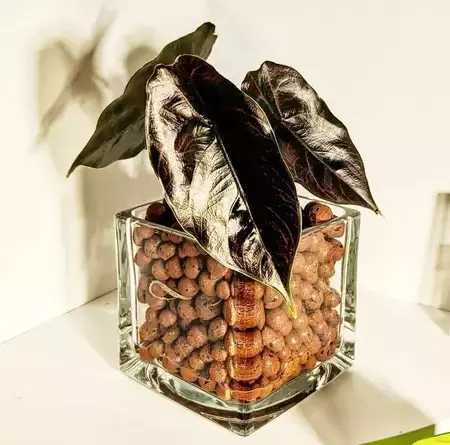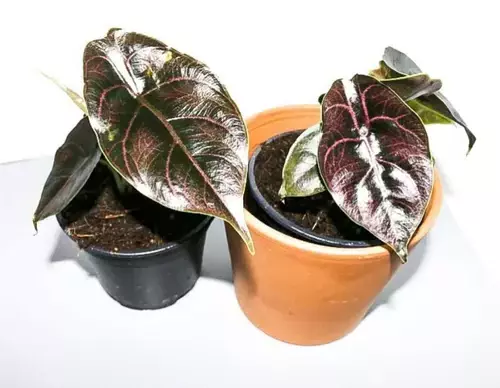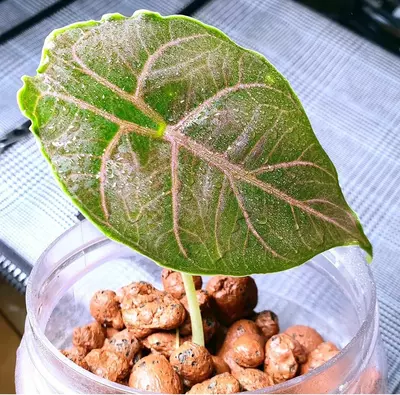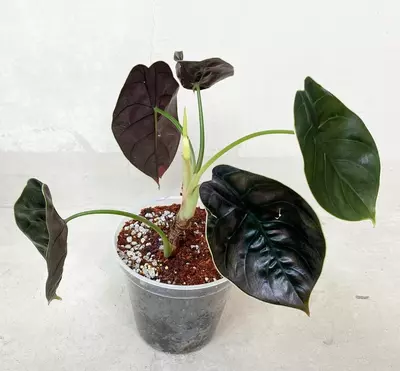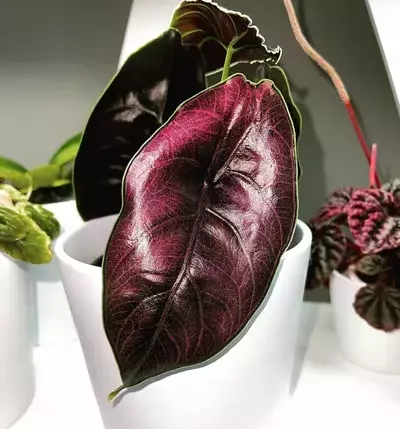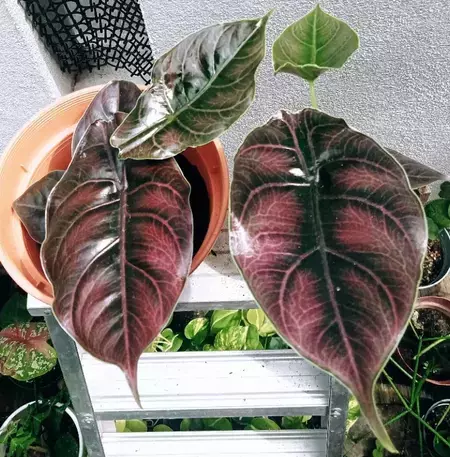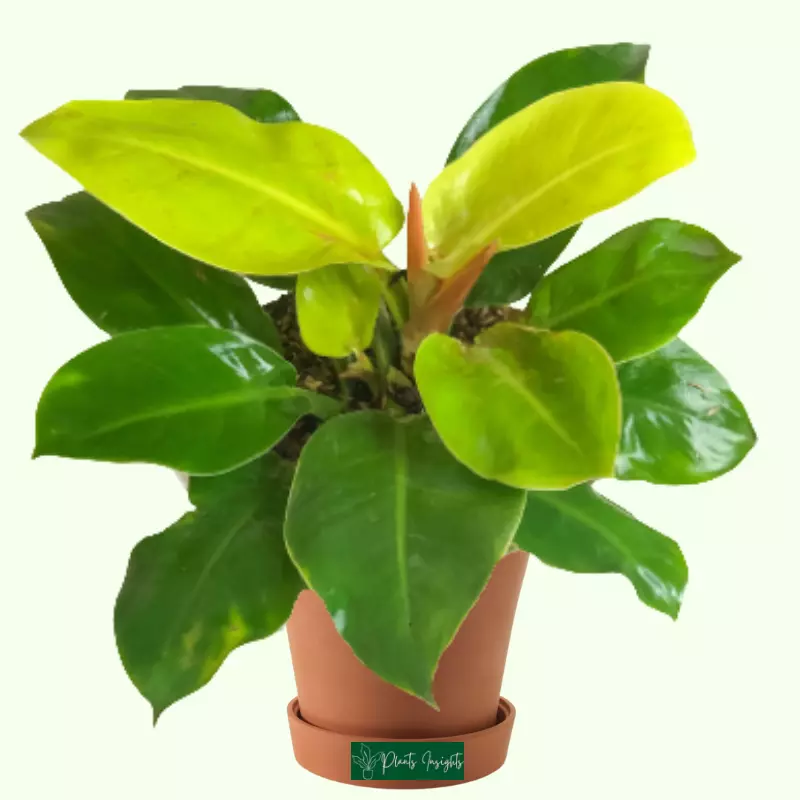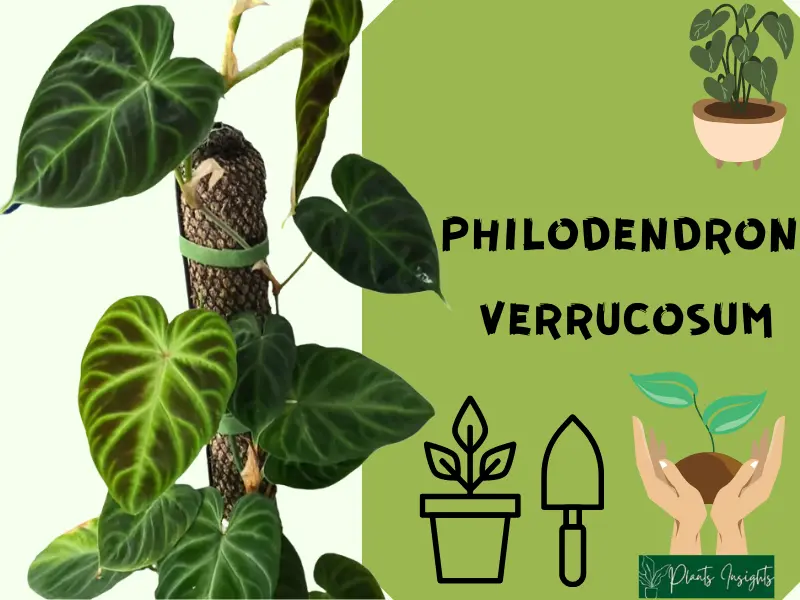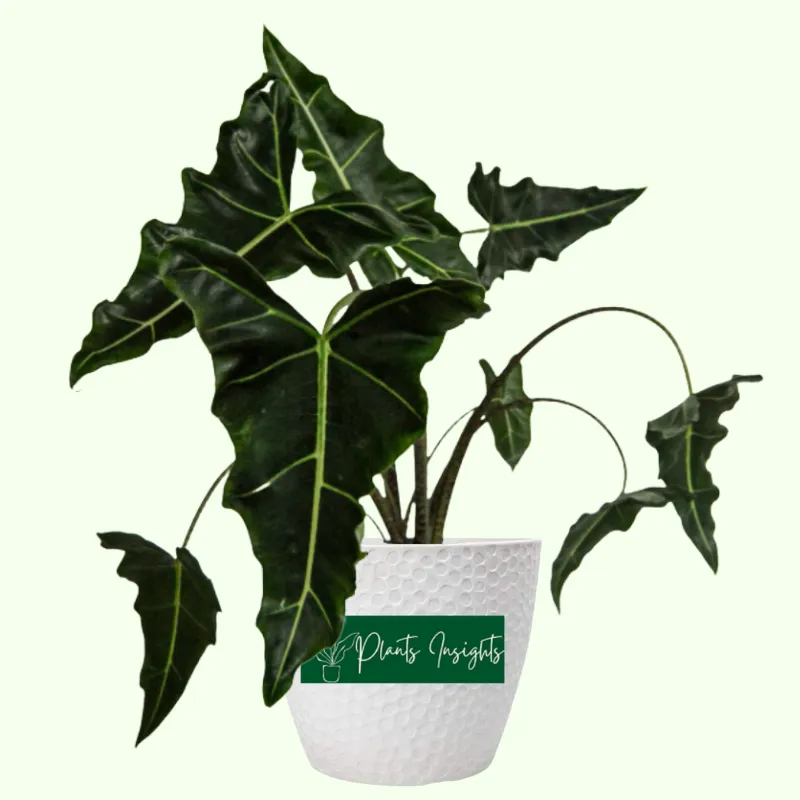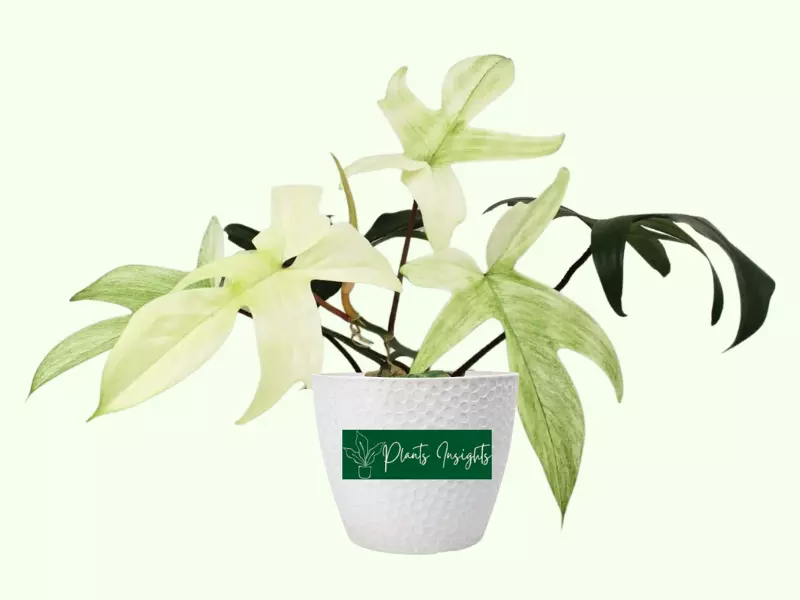Greetings, Lovely Gardeners,
Did you know Alocasia Azlanii is a relatively new and world’s most sought-after jewel Alocasia due to its compact size and spectacular metallic foliage? Hopefully, like me, it is also your dream plant, and you adore its beautiful, magical leaves. The Alocasia Azlanii is a rare Alocasia species because of its distinctive oval-shaped, textured, metallic purple leaves featuring a suffused pink venation and glossy leaves outlined with bright green color. The leaves are the main highlight of this exquisite beauty, exhibiting metallic purple with a saturated pink hue and stunningly red undersides emphasizing the veins, making this dazzling plant an eye-catcher overall.
Due to its unique appearance, this diminutive gem is called other names, such as Red Mambo. This glamorous beauty can make you fall in love at first sight and can add color to your home and office. The compact size of this Diva makes it a perfect centerpiece as a tabletop, or to be placed on a shelf, Ikea greenhouse cabinet, or a windowsill.
Allied Species: Alocasia Bisma, Alocasia Black Velvet, Alocasia Sarian, Alocasia Pink Dragon, Alocasia Lauterbachiana, Alocasia Silver Dragon, Alocasia Stingray, Alocasia Regal Shields, Alocasia Nebula, Alocasia Maharani, Alocasia Jacklyn , Alocasia Cuprea,
Related Products
Products | Name | Check Price |
Organic Perlite for Plants | ||
WONDER SOIL Organic | ||
Orchid Potting Bark Mulch |
Habitat & Ecology
Alocasia Azlanii is one of the 97 Alocasia species in the world, and as mentioned earlier, it is a recently cultivated aroid and is new to the plant industry. This Jewel Alocasia is native to Sarawak on the island of Borneo.
| Botanical Name: | Alocasia Azlanii |
| Family Name: | Arum,,Araceae |
| Common names: | Jewel Alocasia, Red Mambo |
| Plant Type | Herbaceous, Perennial |
| Origin | Borneo |
| Height | 12- 15 inches |
| Flower | Insignificant Inflorescence ( white) |
| Humidity | 60% and above |
| Temperature | 65ºC to 75ºC F (18ºC to 24ºC). |
| Light Need | Bright indirect light |
| Soil Type | Well-draining, moist |
| Bloom time | Spring / Summer |
| Pests | Spider mites, Aphids |
How do you take care of Alocasia Azlanii?
The Alocasia Azlanii is a Diva that needs proper care and maintenance like many other Jewel Alocasias. For instance, it loves to grow in 60% percent humidity, bright indirect light and moderate to warm temperatures ranging from 65 to 75 degrees Fahrenheit. It stays happy in moist well-draining soil and to keep soil moist all the time,water sparingly, but frequently.
In this article, we will cover every part of Alocasia Azlanii’s care; continue reading to learn how I keep my Red Mambo happy and thriving.

Initial Care at Home
When bringing home this beauty, quarantine it before introducing it to other plants in your collection. Carefully inspect the foliage and look for any pests and disease symptoms. If infected, treat the plant before placing it with other plants to prevent the spread.
I would suggest not to rush repotting the plant, let it acclimate for a few week. Alocasias are sensitive to change; therefore your Azlanii may shed leaves in the start which is normal. Alocasias live their lives in Rhizomes; cut off the dead leaves and your plant will grow new foliage.
If you are ordering your Azlanii online, I would suggest ask the seller to cut the leaves and send you the healthy plant stump or rhizome. Alocasias doesn’t like shipping and their leaves may turn yellow along the way. So, its good idea to remove the leaves before shipping to lessen the stress of the plant.

Growth
This striking evergreen tropical plant is a slow grower and can reach a mature height of 1 to 1.5 feet in a few years when it’s grown indoors. The attractive oval-shaped leaves can have a maximum length of 20cm.
Flowering
Alocasia Azlanii occasionally grows inflorescences that are relatively inconspicuous compared to the stunning foliage. Usually Alocasias produce blooms in pairs that you can pollinate to produce seeds.

Watering of Alocasia Reginula
When it comes to watering, the Alocasias are a bit tricky, they need water, but at the same time, they also don’t like to be soaked in it. Once you’ve figured it out, they’ll thrive and produce gorgeous leaves. Like any other Alocasia, the beautiful red Mambo likes to stay moist and intolerant to droughts. Although Alocasia Azlanii like to stay quite moist, but they have very fragile fine roots that need room to breathe between waterings; otherwise, your plant will probably get root rot.
How to Water?
Give your jewel Alocasia sufficient water by checking the top inches of soil to determine the soil moisture. If the 2 to 3 inches of soil is dry, it’s time to water your plant. The watering frequency of Azlanii depends on the season and weather. In dry and hot weather, the plant needs more water, and you may have to water it twice a week, while in cold weather, the frequency reduces to once or twice a month.
The plant should be given adequate water, as infrequent watering can harm its growth. In the case of overwatering, the excess water may accumulate in the soil and cause root rot. To prevent this issue, always use a well-draining potting mix, a pot with drainage holes, and a proper watering schedule according to the plant’s water requirement. Please ensure you water the plant deeply, and let the excess water drains from the soil.
On the other hand, underwatering is also damaging and can result in brown, yellow, and drooping leaves. A wrong watering schedule may cause a leaf loss within hours or plant’s death.
If you keep your Alocasia Azlanii in PON or LECA, the watering schedule looks slightly different because it is like a somewhat self-watering system. You don’t need to worry as much about over-watering. We suggest using self-watering planter because they have a water reservoir and you don’t need to water nearly as much.

Light Need
The amount of light Azlanii receives impacts how metallic and dark its leaves look. If you want the best results, provide lots of bright indirect light to Alocasia Azlanii. Avoid direct sunlight as this plant cannot tolerate intense light, and its metallic leaves may scorch. Therefore, please place it in a spot where it receives indirect bright light for most of the day.
If you are in a tropical region, grow this plant outdoors during the summer, and put them in a greenhouse during winter time. When growing this beauty outdoors, ensure to place it under a shade or where it doesn’t receive intense afternoon sunlight.
The east-facing or south-facing windows are the ideal spots for Azlanii. Low-intensity morning or evening sunrays are beneficial for this plant. However, the plant is sensitive to direct, intense light as it can burn the plant with yellow and brown spots on the foliage. On the contrary, the jewel Alocasia also can’t tolerate low light for an extended period; low light slows growth. Therefore, wisely choose the location for Azlanii’s healthy development.
Alocasia Azlanii craves for light , you can supplement it with grow lights. My Azlanii lives in my Ikea cabinet, so it gets the grow light a decent amount during the day. During winter, the plant may need the grow lights for about seven hours daily. They really need that extra boost if you are in a place where it is dark in Winter and would definitely thank you by producing some fantastic, gorgeous, beautiful leaves.

Humidity and Temperature
Alocasia Azlanii is a tropical lowland plant that prefers high humidity and warmth to thrive. This jewel Alocasia can grow fast in high humidity, ideally 60% and above. Also, sufficient humidity encourages the plant to produce beautiful and vibrant foliage. Though this plant can do well in slightly low humid conditions, but sustained low humidity levels can turn the leaves brown or crispy- that’s a pretty common problem with these ones.
If you notice such signs, try increasing the moisture level by placing a humidifier or pebble tray near your lovely plant or relocate it to more humid places in the house, such as the kitchen or bathroom. Moreover, grouping it with other plants naturally boosts humidity; plus, putting your plant in Ikea Cabinet can provide loads of humidity to this dark metallic gem.
Alocasia Azlanii also loves being in PON or LECA because it creates extra humidity, the water reservoir at the bottom of the PON allows water to just slowly evaporate as well giving a kind of a bubble of humidity around the plant which it adores. It’s just another benefit of why Alocasias should go in PON or LECA.
Winters could be challenging for Azlanii, especially in terms of humidity, as the heaters dries the air resulting in low humidity. Therefore, it’s significant to provide a humid spot in winter.
Temperature
As Alocasia Azlanii hails from a tropical area, it lives happily in warm temperature ranges from 65 to 75 degrees Fahrenheit. It’s important to remember that plant is not cold enduring and cannot tolerate climate conditions under 65 degrees Fahrenheit. Summers are perfect in terms of temperature as it gets enough warmth when kept outside.
Being said that, it also can’t stand sudden temperature fluctuations; therefore, avoid keeping it near air conditioners, heaters, doors, and windows, primarily near cold drafts. The foliage is not frost tolerant so you need to bring them inside during winter. Moreover, you can place Azlanii on a heating pad during winter to prevent it from shock and losing leaves. If your red Mambo is outdoors, bring it indoors when the temperature drops. Always place your plant in warm spots to let it bloom.

Potting Mix
The soil conditions should support the particular needs of this exquisite plant. It requires soil that retains moisture without getting waterlogged. If you’re going to put your plant in a soil medium, a coarse well-draining mix is super important. Plus, putting your plant in a pot with drainage holes is super important because you don’t want just water sitting at the roots of Red Mambo.
We recommend preparing an organic airy soil mix for that contains the following ingredients
Add all the components in a box and thoroughly mix them. Your perfect chunky potting soil is ready for Alocasia Azlanii.
As mentioned earlier these plants are the perfect candidate for PON because it allows that perfect balance of moisture and air especially in a self-watering planters. Moreover, Alocasia Azlanii also enjoys LECA growing medium.

Repotting
Alocasia Azlanii likes to be rootbound and doesn’t like repotting quite often. It can do fine in a single plant for about a year. However, you should report it every two years to keep it healthy.
The other signs of repotting the jewel Alocasia are when the roots start coming out from the drainage holes or when the plant gets a severe infection. In that case, transplanting it into fresh soil is essential.
Another vital point for repotting is that it should be done in the growing season because the plant adjusts to new places easily and can have reduced trauma. When you decide to repot the plant, take a new container that should be one size larger than the current one.
Use fresh and well-balanced potting medium with all necessary nutrients. Lift the Azlanii from the pot and inspect its soil for any sign of disease or infection, in case of any, remove the infected parts and plant it in a new container.
After repotting, give it thorough water, keep it in a ventilated space with bright indirect light, and observe a balanced watering schedule. The plant starts its normal growth in a new pot in a few weeks.

Propagation
Propagation is the process of creating new plants. You can propagate the Alocasia Azlanii by using the following methods explained below. We recommend propagating Azlanii during growing season- spring and summer. The roots will quickly grow and plant will not go under shock.
Propagation through Corms
The easiest and most common way to propagate Alocasia Azlanii is through little corms or bulbs that you might find usually underneath the soil by the roots of your Alocasia plant.
These corms are attached to the roots and comes right off when you pluck them. The best time to collect the corms is during repotting when you can inspect the soil and roots to find any corms. The first thing you want to do is make sure that your corm is firm you do not want it to be squishy because it will rot and won’t grow anything.
Therefore a nice and firm corm is required for propagation. You can use a method called the shallow puddle method where you get a small little container and fill it just a tiny bit with water just so it covers the bulb about halfway and close the container. Just let it sit it doesn’t necessarily need to be anywhere bright. Alternatively, you can place your bulb in sphagnum moss or LECA and keep that container in an Ikea greenhouse cabinet or a grow tent to root ( optional).
Once the corms starts growing roots and sprouting, you can pot them up into your preferred growing medium such as PON, LECA, or aroid potting mix.
Offset Division
It is the easiest method of propagation since Alocasias shoots new plants from the main plant commonly called suckers or offsets. The process is easy and involves separating the offsets from the main stem and planting them in a separate pot. You might want the off set to grow a few leaves and ample roots before clipping it from the mother plant.
Use a sterilized knife or shears to cut the baby plant from the mother plant ( main rhizome). Please do not alter the soil mix and use the same soil in which the parent plant is growing. If the offset has minimal roots, you can propagate it in water to grow ample roots before planting it in the potting mix. Retain the soil moist until the plant gets established. Keep the offset in medium light until it established the root system and start shooting new growth.
Rhizome Division
Alocasia Azlanii is a rhizomatic plant and you can divide the rhizomes ( the thick stem of the plant) into two or more pieces and plant them in separate pots. Please ensure each section has a growth node (an indentation where a new leaves sprout). Use the same soil as the parent plant and keep them in a humid place with ample indirect sunlight. Remember to maintain the soil moist until you notice new growth, after which you can recommence regular watering.
Seeds Propagation
You can propagate the Alocasia Azlanii through seeds; however, it is not a very successful method. Although it’s a slow and unreliable process, but it’s possible.
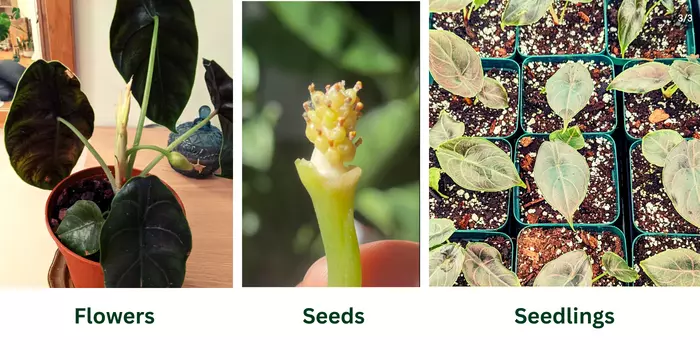
Alocasias produce inflorescences in pair that can be pollinated first if you want to use homegrown seeds. When pollinated it will take about a month or two for the plants ovaries to swell and become fruits which contain the seeds.
Once you have the berry after pollination, remove the seeds from the berry and soak them overnight in distilled water. Plant the seeds into approximately 1.5cm (0.5 inches) in a specially prepared soil mix. Spray the soil to keep it moist and keep them in a warm place to germinate. It may take approximately two months to germinate and become seedlings. Later, transplant them in separate pots into well draining potting mix.

How often should I fertilize my Alocasia Azlanii?
The Alocasias are not heavy feeders but fertilizing helps your plant to look and feel healthier. The fertilizing needs vary from season to season; your plant needs more feed during the growing season (spring and summer) as it wants more nutrients for its development. Therefore, balanced liquid fertilizer with all micro and macronutrients can benefit your red Mambo, while in winter, the plant enters dormancy and doesn’t need much feed.
You can use liquid Gold leaf fertilizer for hydroponics or semi-hydro or even if your plant is in the soil. For liquid all-purpose fertilizer ,make sure to try half strength before going all in with it because some of those all-purpose fertilizers can really burn the roots of the plant which is not ideal.
If your plant is in the soil, a monthly or every two weeks feeding is sufficient, and a balanced liquid houseplant fertilizer or a slow release fertilizer is impeccable for this plant and will do the job.
When fertilizing the plant, ensure not to overfeed the plant as overfeeding doesn’t help in plant health and growth; instead, it can cause the plant to burn.

Maintenance:
The Azlanii is a slow and compact grower that might need occasional pruning to maintain its shape and attractiveness. Pruning is required to remove dead and damaged leaves. Always use a sterilized pair of scissors or shears to snip the damaged or dead leaves.
Regularly wipe the glossy leaves to prevent the pore’s blocking and photosynthesize better. Plus, rotate your plant every other week to let it grow equally from all sides.

Toxicity
Like all other Alocasias, the Azlanii contains calcium oxalate crystals that are toxic to humans and pets. Keep your children and pets away from this plant. Ingestion can result in skin and mouth irritation and sometimes can cause swelling. In case of consumption, take immediate medical assistance. It’s also recommended to use gloves when pruning the Alocasia Azlanii.

Common Problems and Pests
Pests
Alocasias are incredibly vulnerable to pests outbreak. Pests are like a nightmare to the plant; therefore, stay vigilant to any pest attack that can destroy your beloved plant. The most common pests that can harm Azlanii are spider mites and aphids.
Spider mites
These are tiny creatures that are invisible to the naked eye. They can spread through infected plants and even through humans. The leading cause of spider mite attacks is a dry climate; the main signs are yellow or brown spots on the leaves and webbing in the plant. To treat them, apply neem oil or spray with a soap water solution on the affected areas. To prevent their occurrence, maintain sufficient moisture.
Aphids
These are tiny bugs that are extremely dangerous for your Alocasia. They cause nutrient exhaustion in the plant by sucking the sap, which can weaken the plant’s transport system. Aphids can also become a medium for molds that hinders photosynthesis and cause fungal growth.
Upon identification of aphids attack, isolate your plant and spray insecticidal spray all over the plant to remove any signs of aphids and their eggs. Neem and canola oil are also excellent options to treat aphids.
Diseases
The red Mambo can encounter many diseases; the most common is root rot. Root rot can ultimately damage the plant and often can result in plant death if not treated on time.
Causes: The most common cause of root rot is overwatering. If your plant gets more water than its needs, it can accumulate water in the soil, which results in many problems, including root rot.
Signs: The significant symptoms of root rot in Azlanii are mushy stem, yellow, discolored or dropping leaves, foul smell, and stunted growth.
Treatment: To treat the Alocasia Azlanii for root rot, apply fungicide all over the plant. You can also repot the plant in a new container with fresh soil after removing the infected parts.
Common Problems
The jewel Alocasia is a delicate plant and may run into many problems. The most common issue that the plant can have are
Yellow leaves: The yellow leaves are a sign of either over-watering or underwatering. When you spot yellow leaves on the Azlanii, recheck the watering schedule and water it only when the top inches of soil are dry.
Brown leaves: The brown leaves are caused by low humidity and a dry environment. Try increasing the humidity level around your plant and maintaining the soil moisture.
Leaf Spots: Usually leaf spots is a sign that your plant is in a shock. The leaf spots may appear after you repot your plant. Unfortunately there is no remedy to fix the damage. That leaf will eventually die and new leaf will grow to replace that. However, to prevent the shock try using the potting mix for repotting similar to the old one.

Frequently Asked Questions
Why is my Alocasia Azlanii drooping?
The main cause of drooping leaves in Alocasia Azlanii is overwatering or underwatering. If your plant remains dry for a long time, it can cause the leaves to lose their strength, resulting in drooping leaves.
Can Alocasia survive without leaves?
Alocasias are hardy plants, and unlike other tropical plants, they can bounce back after losing all leaves. This is because they reserve the energy in the thick tubers, which helps them to survive.
Why is My Alocasia Azlanii Shedding Leaves?
If Alocasia Azlanii stress out they tend to shed leaves. Moreover, they drop leaves to make space for new leaves to grow. At a time single Azlanii can have 4 to five leaves.
Why are the leaves of Alocasia Azlanii turning yellow?
Alocasia Azlanii is highly sensitive to their environment. If the leaves are turning yellow, it might indicate that the soil has been too wet or dry for a long time. Inspect the soil moisture before watering your plant, and don’t let your plant bone dry between watering.
Why does Alocasia cry?
It’s the guttation process that makes Alocasias cry. When the plant drips the water from its leaves, it means it is experiencing guttation, which is the process that occurs when the plant takes more water than it needs and releases surplus water through its leaves. Guttation is normal in all Alocasias.
How do you revive a dying Alocasia?
For reviving the dying Alocasia, plant it in a pot with drainage holes and use a well-draining potting mix. Water it only when the top 2 to 3 inches of soil is dry, provide it with sufficient bright indirect light for 6 to 8 hours a day, and keep it in a warm and highly humid location.
How do you know if Alocasia is dormant?
Suppose you aren’t sure whether your Alocasia is dormant or not. To check that, remove the plant from the container and inspect its roots. If the roots are dried or started to rot, the plant is dead; however, a dormant plant’s roots will be completely normal.
Is the Alocasia Azlanii rare?
Alocasia Azlanii has gained popularity in recent years and is highly sought-after plant. But, it is not rare as it is being cultivated in many plant nurseries.

Final Words
Alocasia Azlanii is a stunning houseplant that every plant lover anticipates. Its exceptional foliage makes it a center of attraction that can enrich any space.
This loveliness belongs to the tropical island of Borneo and appreciates high humidity and warm temperature, bright indirect light, and well-draining soil. Mimicking its native climate makes this plant happy and encourages growth.
If you are a plant fanatic, we highly recommend you bring this exquisiteness home and enjoy the perks of having the wonderful jewel Alocasia.
Although it’s a little picky plant and will need your care and attention but, it’s worth it. We hope you have liked this article, and it will help you grow this superb beauty in your home with care.
Happy Planting Jewel Alocasia!!!
Related Posts
Best Fan for Grow Tent | Clip On, Inline & Oscillating
Grow tent fans are specially designed to increase air circulation and ventilation. If you want to regulate the environment of your indoor growing space effectively, you need best grow tent fans .
Philodendron Moonlight Care & Growing Guide
The Moonlight Philodendron is a hybrid variety of the Philodendron genus from the Araceae family grown for its vivid foliage.
Philodendron Verrucosum (Ecuador Philodendron) Care
The Philodendron Verrucosum is a show stealer and one of the most stylish of all Philodendrons. The Philodendron Verrucosum is a flowering hemiepiphytic climber of the Araceae family.
Alocasia Sarian | Elephant Ear Plant Care
Alocasia Sariana (Elephant ear) is hybrid of the Zebrina and Micholitziana Alocasias featuring ginormous deep green pointed leaves.
Philodendron Florida Ghost or Florida Mint
The Philodendron Florida Ghost also known as Philodendron Pedatum is an affordable “rare” Philodendron that is easily attainable.






